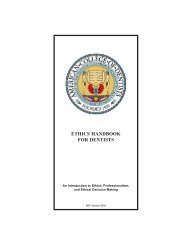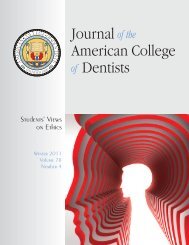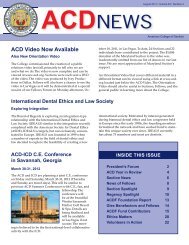JACD 71-4 - American College of Dentists
JACD 71-4 - American College of Dentists
JACD 71-4 - American College of Dentists
- No tags were found...
Create successful ePaper yourself
Turn your PDF publications into a flip-book with our unique Google optimized e-Paper software.
National Leadership Symposium<br />
34<br />
that drives the engine <strong>of</strong> technology.<br />
Science is an international enterprise.<br />
Science can be a noun, an adjective, and<br />
a verb, as in “doing science.” Scientific<br />
activity can be “disciplined-based” or<br />
“interdisciplinary.” Science and its<br />
<strong>of</strong>fspring, science-based technology,<br />
have both lengthened the human life<br />
span and lightened the human workload<br />
during the twentieth century. Science<br />
has enriched our acquaintance with the<br />
universe, our planet, and ourselves.<br />
Science at its best is the light <strong>of</strong> enlightenment<br />
and is fascinating. The wealth,<br />
well-being, and creative powers <strong>of</strong> our<br />
culture depend heavily on science and<br />
technology. The very essence <strong>of</strong> science<br />
is truly a passion and state <strong>of</strong> mind. Its<br />
aim is to get at truths about how reality<br />
works. Of course, science requires leadership,<br />
management, and genius.<br />
My thesis is “leadership and organizing<br />
genius.” All too <strong>of</strong>ten the public<br />
perceives science as a lonely pr<strong>of</strong>ession,<br />
the province <strong>of</strong> the lone genius working<br />
alone in a laboratory, clinic, or hospital.<br />
Ironically, modern science has become<br />
a pr<strong>of</strong>oundly collective enterprise. The<br />
modern realization that science is highly<br />
competitive while being highly collaborative<br />
emerged during World War II,<br />
and continued in the postwar years.<br />
Teamwork, collaborations, and the<br />
organization <strong>of</strong> genius into “great<br />
groups” have proliferated and have now<br />
become the norm. I want to explore<br />
“leadership and organizing genius” by<br />
using three examples or models: 1) The<br />
Manhattan Project led by J. Robert<br />
Oppenheimer; 2) The Human Genome<br />
Project led by Francis Collins; and 3)<br />
The International SARS Consortium—<br />
ironically “led” without a “leader.”<br />
In each <strong>of</strong> these three examples we<br />
will discover individual genius, high<br />
adventure, high competition, the<br />
emergence <strong>of</strong> interdisciplinary teams <strong>of</strong><br />
scientists, and enormous collaborations,<br />
either driven by a remarkable leader or<br />
driven from within by highly gifted<br />
scientists working in “great groups.”<br />
The common threads that are woven<br />
through these three examples will<br />
highlight “the need to recognize the<br />
division <strong>of</strong> cognitive labor,” as science<br />
and disciplines have become increasingly<br />
specialized, and the growing realization<br />
that scientists who collaborate with<br />
each other are more productive, <strong>of</strong>tentimes<br />
producing better science, than are<br />
individual investigators working alone.<br />
Manhattan Project<br />
In the first example, the Manhattan<br />
Project was established by the United<br />
States government in 1942. The Department<br />
<strong>of</strong> Defense recruited U.S. Army<br />
Brigadier General Leslie R. Groves to be<br />
the leader <strong>of</strong> the Manhattan Project with<br />
full control—authority, responsibility,<br />
accountability, and budget. The project<br />
was based in Los Alamos, New Mexico.<br />
General Groves was in charge. He recruited<br />
Pr<strong>of</strong>essor J. Robert Oppenheimer, a<br />
world-class academic physicist, who in<br />
turn functioned to recruit and organize<br />
a genius team <strong>of</strong> scientists such as<br />
Enrico Fermi and Harold Urey, and then<br />
to motivate, inspire, cajole, and eventually<br />
synthesize the scientific and technological<br />
results that produced the first successful<br />
atomic bomb test on July 16th, 1945.<br />
Thereafter, two atomic bombs termed<br />
“Fat Man” and “Little Boy” were dropped<br />
on Hiroshima and Nagasaki in August<br />
1945. This remarkable accomplishment<br />
was achieved in the context <strong>of</strong> war,<br />
extreme secrecy, fear <strong>of</strong> competition<br />
with German technological talent, and<br />
the truly remarkable collaborations<br />
between disparate and <strong>of</strong>ten conflicting<br />
scientific genius.<br />
The Manhattan Project model has<br />
been used by many government scientific<br />
projects for the last fifty years such as<br />
polio in the early 1950s, the mission to<br />
the moon in the 1960s, AIDS in the early<br />
1980s, and anti-bioterrorism at the<br />
moment. This model reflects a defined<br />
problem or goal (e.g. “The War on<br />
Cancer”); the complexity as well as<br />
multiple tensions found between<br />
government-oriented, industry-oriented,<br />
and university-oriented scientists; and<br />
tensions over intellectual property<br />
and “who gets the credit.”<br />
Mapping the Human Genome<br />
The second “leadership and organizing<br />
genius” example is the Human Genome<br />
Project (HGP). Curiously, this model<br />
evolved from dreams <strong>of</strong> mapping the<br />
fruit fly genome. Leadership is kindled<br />
by hopes and dreams <strong>of</strong> what could be.<br />
From my perspective, “none <strong>of</strong> us is as<br />
smart as all <strong>of</strong> us.” The HGP demonstrated<br />
and continues to demonstrate that<br />
collaborative leadership is that <strong>of</strong>ten rare<br />
characteristic that can achieve true greatness<br />
in science, technology, and in the<br />
arts. Collaborative leaders are able to<br />
assemble great teams <strong>of</strong> talent—to organize<br />
genius. Such leaders read and listen<br />
and internalize disparate points <strong>of</strong> view.<br />
They discover essential “truths” and<br />
communicate in direct and simple language.<br />
Great teams reflect highly<br />
creative individuals working closely with<br />
one another in collaboration to achieve<br />
<strong>of</strong>ten high-risk objectives.<br />
Consider the dream and opportunity<br />
to map the human genome. The mission<br />
2005 Volume <strong>71</strong>, Number 4





